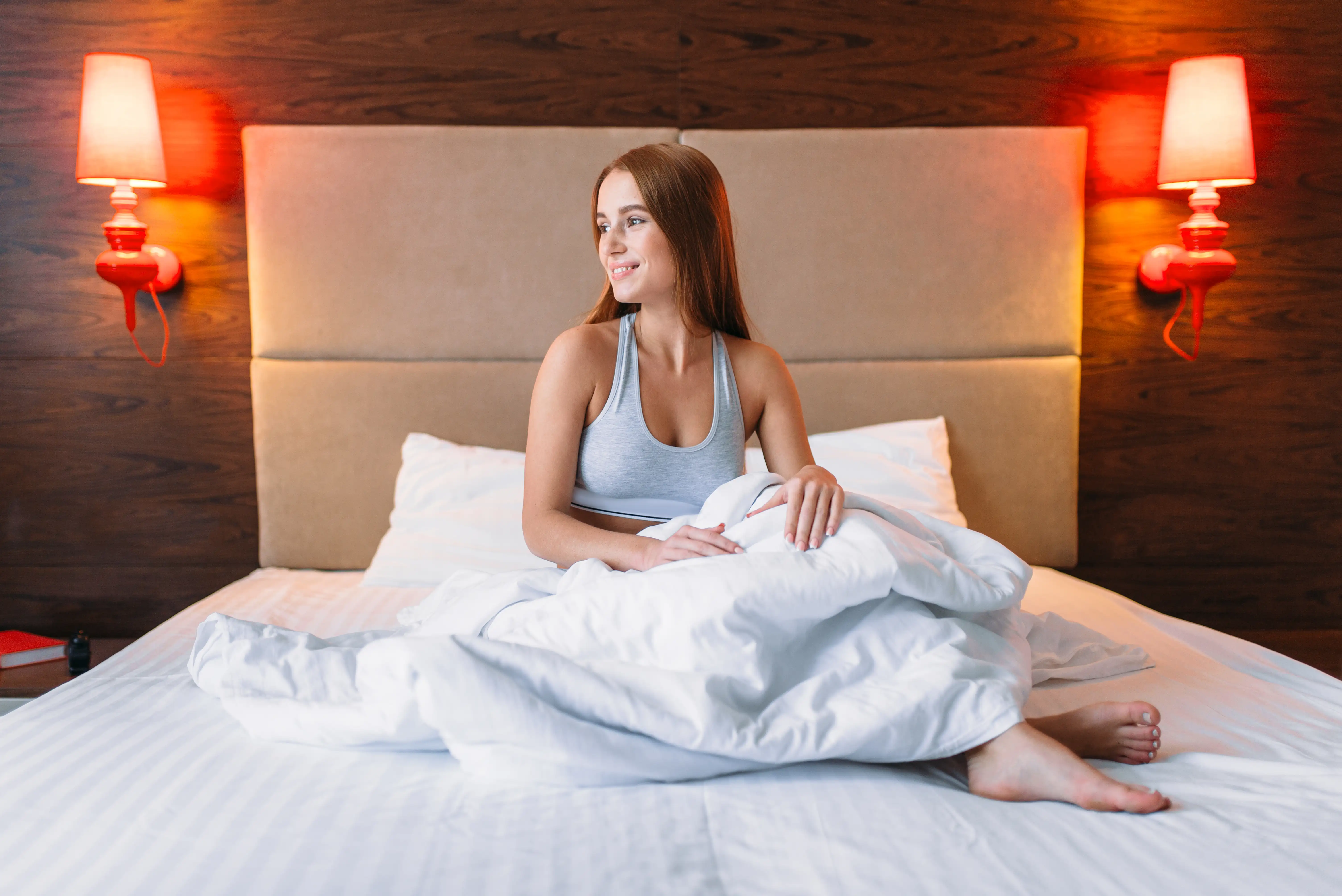If you’ve ever stayed in a nice hotel and wondered why the bed felt so much better than your one at home, you’re not alone. Hotel beds are known for their comfort, crispness, and luxurious feel, and the secret lies largely in the bedding.
From high-thread-count sheets to fluffy duvets and perfectly layered pillows, hotels use specific types of bedding designed to maximize comfort, cleanliness, and style.
In this article, we’ll break down exactly what kind of bedding hotels use and how you can recreate that 5-star signature sleep experience at home.
Why Hotel Bedding is Different
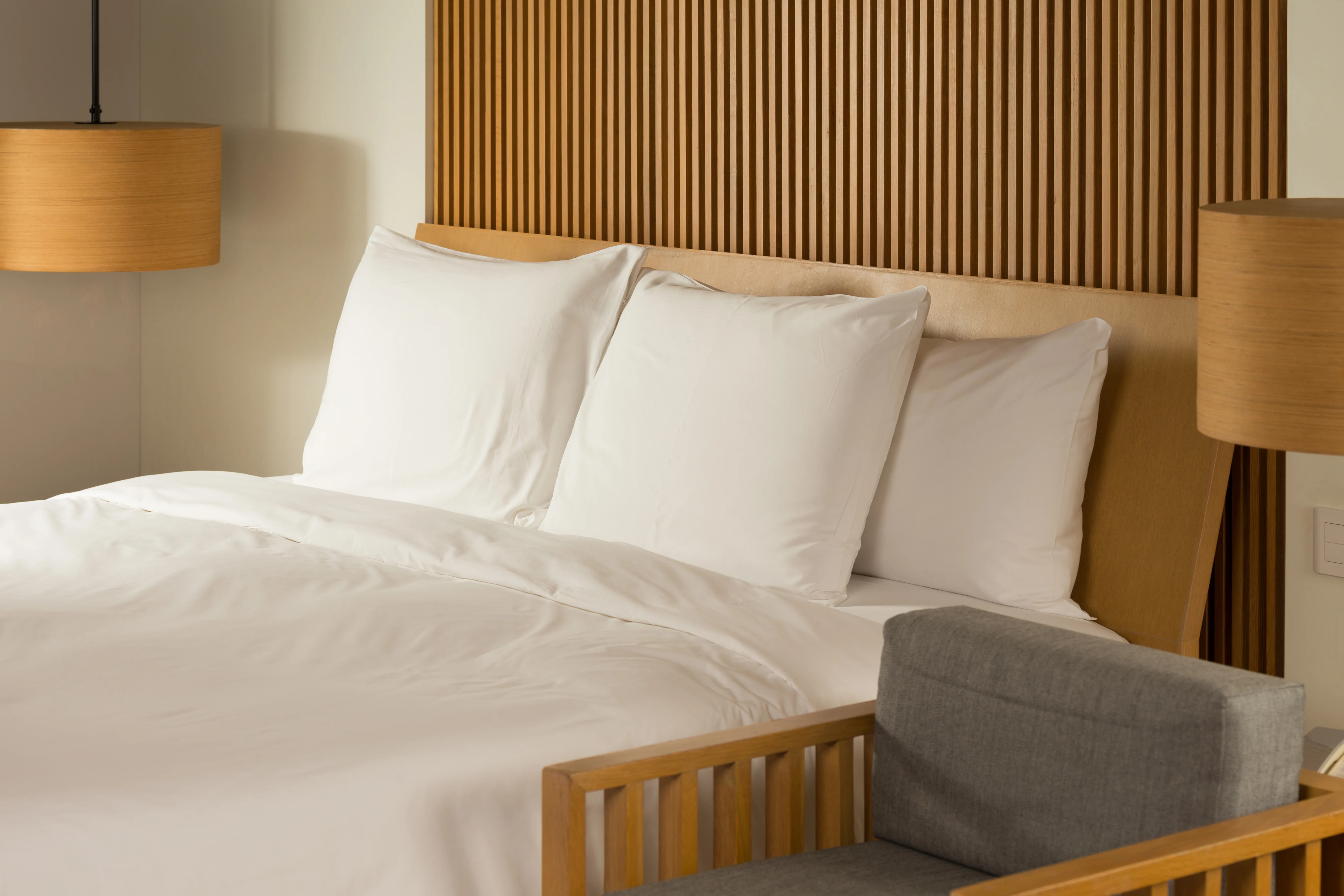
Hotel bedding isn’t just about looking appealing; it’s carefully chosen to meet high standards for comfort, durability, and cleanliness. Every layer is designed with both guest satisfaction and practical hotel operations in mind, making it noticeably different from what you might find in the average home.
High-Quality Materials for Durability and Comfort
Hotels use materials like long-staple cotton, cotton-poly blends, or TENCEL™ to ensure a balance of softness and strength. These fabrics are not only gentle on the skin but also durable enough to withstand repeated industrial laundering without losing their feel or color.
Designed to Enhance the Guest Experience
Crisp white sheets, plush duvets, and a perfectly tucked bed all play into the sense of luxury and cleanliness that guests expect. The bedding is part of the overall hotel experience, making the room feel more like a retreat and less like a stopover.
Easy to Clean and Maintain at Scale
Hotels use hypoallergenic bedding that must be washed daily or between every guest stay. This means choosing materials that can handle frequent high-temperature washes without pilling, shrinking, or fading. Most hotel sheets are wrinkle-resistant and quick-drying to streamline housekeeping operations.
Often Purchased in Bulk for Consistency
Hotels typically buy bedding in bulk from commercial suppliers to ensure every room feels the same. This bulk purchasing also helps them maintain consistency in texture, color, and comfort, so the brand experience is uniform across all locations.
Hotel Bedding Basics: What’s on a Hotel Bed?
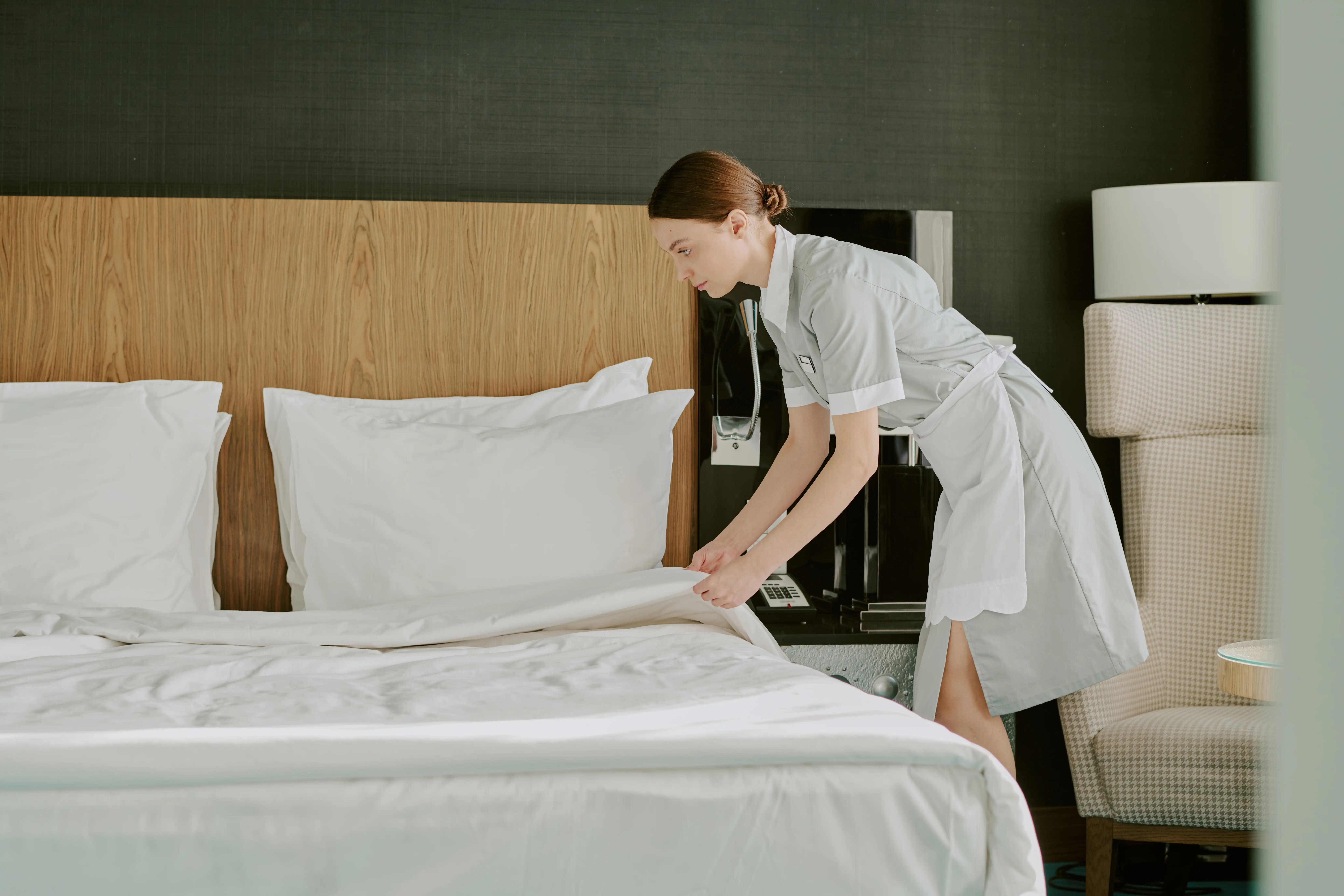
The inviting, cloud-like look of a hotel bed isn’t accidental. Hotels use a strategic layering system to achieve that signature comfort and presentation.
In hotel bedding sets, each component serves a functional and aesthetic purpose, from the crisp sheets to the perfectly fluffed pillows and decorative top layers. Hotels often layer their beds with premium linens, including high thread count sheets, duvet covers, and pillowcases, to achieve that crisp, inviting feel.
Hotel Bedding Layers
Hotels typically use multiple bedding layers for both comfort and hygiene. These usually include a mattress protector, fitted sheet, flat sheet, duvet insert with a cover, a blanket or comforter, and often a decorative throw.
Each layer serves a purpose: mattress protectors extend the mattress's life and keep it clean, sheets offer a crisp, fresh feel, and duvets provide warmth.
The layered approach allows hotels to easily wash and replace individual pieces, maintain cleanliness between guests, and create a luxurious, well-made bed appearance.
Why So Many Layers?
Hotel beds are layered not just for luxury but to prioritize hygiene, durability, and guest comfort. The typical setup starts with a mattress protector that shields the mattress from spills and allergens, followed by a fitted sheet that provides a smooth, secure base. On top of that comes a flat sheet, which adds softness and is easier to clean.
The main warmth layer is usually a duvet insert or comforter, often encased in a washable duvet cover or sandwiched between two flat sheets in what's known as the triple-sheeting method. A blanket or decorative coverlet may be added for extra warmth or aesthetic appeal, while pillow inserts are neatly arranged with fresh pillowcases and sometimes finished with decorative euro shams.
Many hotels also use a bed scarf or throw blanket at the foot of the bed to enhance visual appeal. This multi-layered approach allows housekeeping to refresh only the necessary components between guests, improving efficiency and cleanliness, while also letting guests adjust the bedding to their preferred level of warmth and comfort.
Types of Bed Bases Used in Hotels
The comfort of a hotel bed isn’t just about plush pillows and soft sheets; the foundation matters just as much. Bed bases play a key role in mattress support, overall sleep quality, and even the look and feel of the room.
Hotels choose specific types of bases depending on design goals, durability, space-saving needs, and guest comfort expectations. Below are the most common types of bed bases you’ll find in hotels and what makes each one unique.
Platform Bases
Platform bases are a popular choice in contemporary hotels thanks to their clean, minimalist look and sturdy structure. They consist of a solid or slatted surface that supports the mattress without needing a box spring. Hotels appreciate them for their low maintenance, durability, and ability to match a wide range of décor styles.
Box Springs
Many traditional or mid-range hotels still use box springs, a classic base made with a wooden frame and coils or springs inside, wrapped in fabric. Box springs add height to the bed and absorb movement, making the mattress feel softer and more cushioned. They're especially useful for innerspring mattresses.
Adjustable Bases
Adjustable bed bases are often reserved for luxury suites or wellness-focused hotels. A high-end hotel bed base allows guests to elevate their head, feet, or both using a remote control. They’re ideal for travelers who want customizable comfort, whether for reading, watching TV, or alleviating health concerns like snoring or acid reflux.
Slatted Bases
Slatted bases feature a series of flexible or fixed wooden slats across the bed frame, providing breathable support for the mattress. Boutique hotels may choose these for their eco-friendly appeal and lighter structure. The spacing of the slats can affect mattress firmness, making it a versatile option depending on the brand and guest preferences.
Divan Bases
Common in the UK and many European hotels, divan bases are upholstered frames that often include built-in storage drawers. They combine practicality and comfort, offering extra space for luggage or linens while maintaining strong mattress support. Their padded finish also adds a touch of softness and sophistication to the room.
What Mattresses Do Hotels Use?
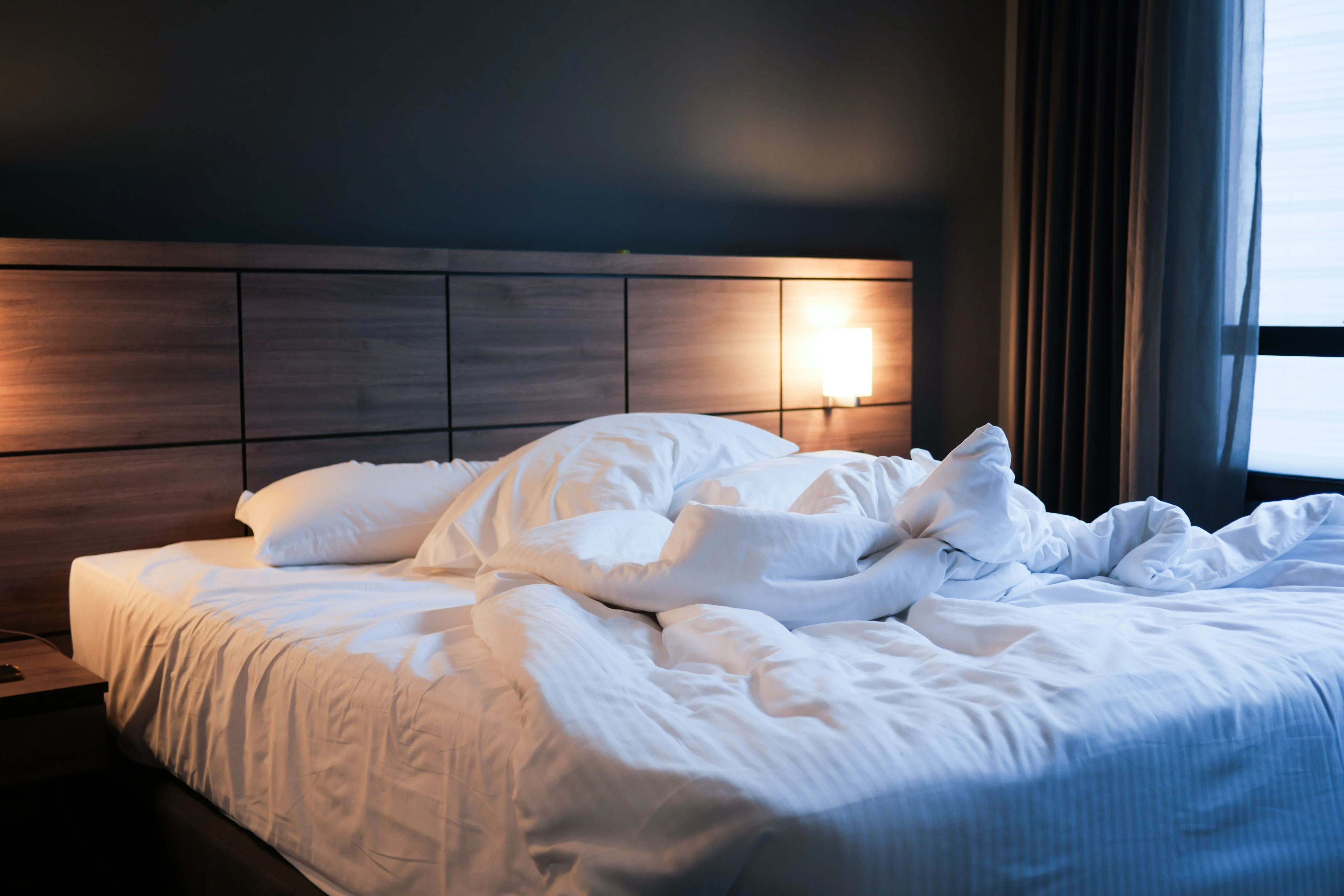
The luxurious comfort of a hotel bed isn’t just about the sheets; it starts with what’s underneath. Hotels invest in high-quality mattresses and supportive bed bases designed to deliver consistent comfort to a wide variety of sleepers night after night.
These components are chosen not only for comfort but also for durability, hygiene, and ease of maintenance.
Mattress Type
Most hotels go for medium-firm innerspring or hybrid mattresses because they offer a reliable balance of support and comfort. These mattresses are built to withstand frequent use while maintaining their shape and feel over time.
Hybrid models, which combine innerspring coils with memory foam or latex layers, are especially popular in higher-end hotels as they contour to the body while still offering the bounce and support guests expect.
Pillowtop Mattress
To create that signature plush hotel feel, many establishments add a pillowtop layer to their mattresses. A pillowtop is a soft, quilted layer sewn onto the top of the mattress, often made from foam or fiberfill. It adds an extra touch of cushioning without compromising on support.
This layer is what often gives hotel beds their cloud-like softness and helps reduce pressure points for a more restful night’s sleep.
Hotel Mattress Protectors
While often overlooked, mattress protectors are a key component of hotel bedding. They serve as a barrier between the mattress and the guest, helping to preserve the bed's hygiene and lifespan.
Hotels choose protectors that are durable, comfortable, and discreet—ones that enhance rather than detract from the sleep experience.
Material and Fabric
Hotel mattress protectors are typically made from a blend of polyester and cotton, combining softness with resilience. Some higher-end hotels may use protectors with added padding or quilted tops for an extra layer of comfort.
The fabrics are chosen to be smooth and quiet, ensuring they don’t make noise or cause friction beneath the sheets.
Waterproofing and Allergen Protection
One of the primary purposes of a mattress protector is to guard against spills, sweat, and accidents. Most hotel-grade protectors feature a waterproof layer made of polyurethane, which is thin enough to be breathable but effective in preventing liquids from seeping into the mattress.
This same layer also helps block allergens like dust mites and bacteria, maintaining a healthier sleep environment for guests.
Breathability and Comfort
Despite their protective function, hotel mattress protectors are designed to be breathable to avoid trapping heat. Many feature moisture-wicking technology or airflow-enhancing weaves to maintain a cool and dry sleep surface.
A well-designed protector won’t interfere with the feel of the mattress; it will simply add a layer of protection without compromising comfort.
Fit and Construction
To ensure ease of use for housekeeping staff and a smooth sleeping surface for guests, hotel mattress protectors are made with deep pockets and elasticized edges.
This helps them stay securely in place throughout the night and during sheet changes. The fit is snug but not overly tight, accommodating various mattress heights, including pillowtop and hybrid styles.
What Kind of Sheets Do Hotels Use?
Hotel sheets are renowned for their crisp feel, smooth texture, and timeless white appearance. But the secret behind that luxury hotel bed isn’t just a high thread count; it’s a combination of the right fabric, weave, and quality control. Hotels carefully select fitted sheets that can withstand frequent washing while still delivering a soft, fresh sleep surface.
Weave Type
The most common weave used in hotel sheets is percale, known for its crisp, cool, and matte finish. Percale is a plain weave with a one-over-one-under structure, which gives it a lightweight, breathable feel that stays smooth against the skin.
Some upscale hotels may also use sateen weave sheets, which have a slightly heavier, silkier texture and a subtle sheen. The hotel's climate, aesthetic preferences, and brand standards often influence the choice between percale and sateen.
Thread Count
While many people associate high thread count with luxury, hotels typically go for sheets with a thread count in the 250–400 range. This range balances softness, durability, and breathability.
Higher thread counts can trap heat and wear out more quickly, especially with frequent laundering. Hotels focus on the quality of fiber and weave rather than just thread count, ensuring their sheets feel luxurious while holding up under commercial use.
Fabric Type
High-end hotels typically use linens made from 100% cotton, Egyptian cotton, or sateen cotton for their softness, breathability, and durability.
Some hotels also use cotton-polyester blends, which are more wrinkle-resistant and easier to care for without sacrificing too much softness. The emphasis is on fabrics that can maintain a fresh, clean feel after many washes without pilling or fading.
What Kind of Comforters and Duvets Do Hotels Use?
The comforter or duvet is a key part of the hotel bedding experience, offering warmth, softness, and a luxurious feel. Hotels choose comforters and duvets that not only ensure comfort but are also durable, easy to care for, and in line with the hotel's aesthetic and climate. Let’s break down the key elements of hotel comforters and duvets.
Hotel Comforters vs. Duvets
While the terms "comforter" and "duvet" are often used interchangeably, they differ in design and function. Comforters are typically filled and sewn shut, requiring no extra cover, while duvets are designed to be used with a removable cover.
Many hotels use comforters in rooms with more relaxed or casual settings, as they are easier to maintain, while higher-end or boutique hotels prefer duvets for their customizable and fresh appearance.
Material
Most hotel comforters and duvets are filled with down or down-alternative materials. Down is the soft, insulating layer found beneath the feathers of ducks or geese and is known for its lightness and superior warmth-to-weight ratio.
For guests with allergies or preferences, many hotels use down-alternative fillings, which are made from synthetic fibers and mimic the warmth and softness of down. Both types are popular due to their breathability, softness, and ability to retain warmth.
Duvet Inserts
A duvet insert is typically the fill inside a duvet cover, and hotels often use inserts made from natural down or synthetic microfiber. These duvet inserts provide warmth and softness without being overly heavy, making them ideal for hotel beds.
Synthetic inserts tend to be easier to maintain, hypoallergenic, and more affordable, while down duvet inserts offer the luxurious feel and natural warmth many guests expect.
Duvet Covers
Duvet covers used in hotels are often made from high-quality materials like Egyptian cotton or sateen, which can make them quite pricey, but they’re key to achieving that luxurious, hotel-like feel. These covers serve both protective and decorative roles, keeping the duvet clean and fresh while also allowing hotels to easily change the look of the bedding.
White duvet covers are most common, as they symbolize cleanliness and offer a crisp, elegant appearance. Hotel duvet covers are usually designed for easy removal and laundering, as they need to withstand frequent cleaning between guests.
Weight
The weight of hotel comforters and duvets is crucial for comfort, as it affects warmth and the overall sleep experience. Hotels typically choose medium-weight comforters that provide enough warmth without being too heavy.
These comforters are perfect for various climates and seasons, as they can be easily adjusted or swapped depending on the weather. The balanced weight ensures guests stay comfortable throughout the night, whether it’s summer or winter.
Design
While a hotel comforter and duvet are designed for comfort, they also play a role in the room's overall aesthetic. Most hotels go for simple, elegant designs that complement the decor of the room, often in solid colors like white, ivory, or beige.
Some higher-end hotels use duvets or comforters with subtle patterns or textured fabrics, adding a layer of luxury without overwhelming the room’s decor.
Hotel Blanket Throws
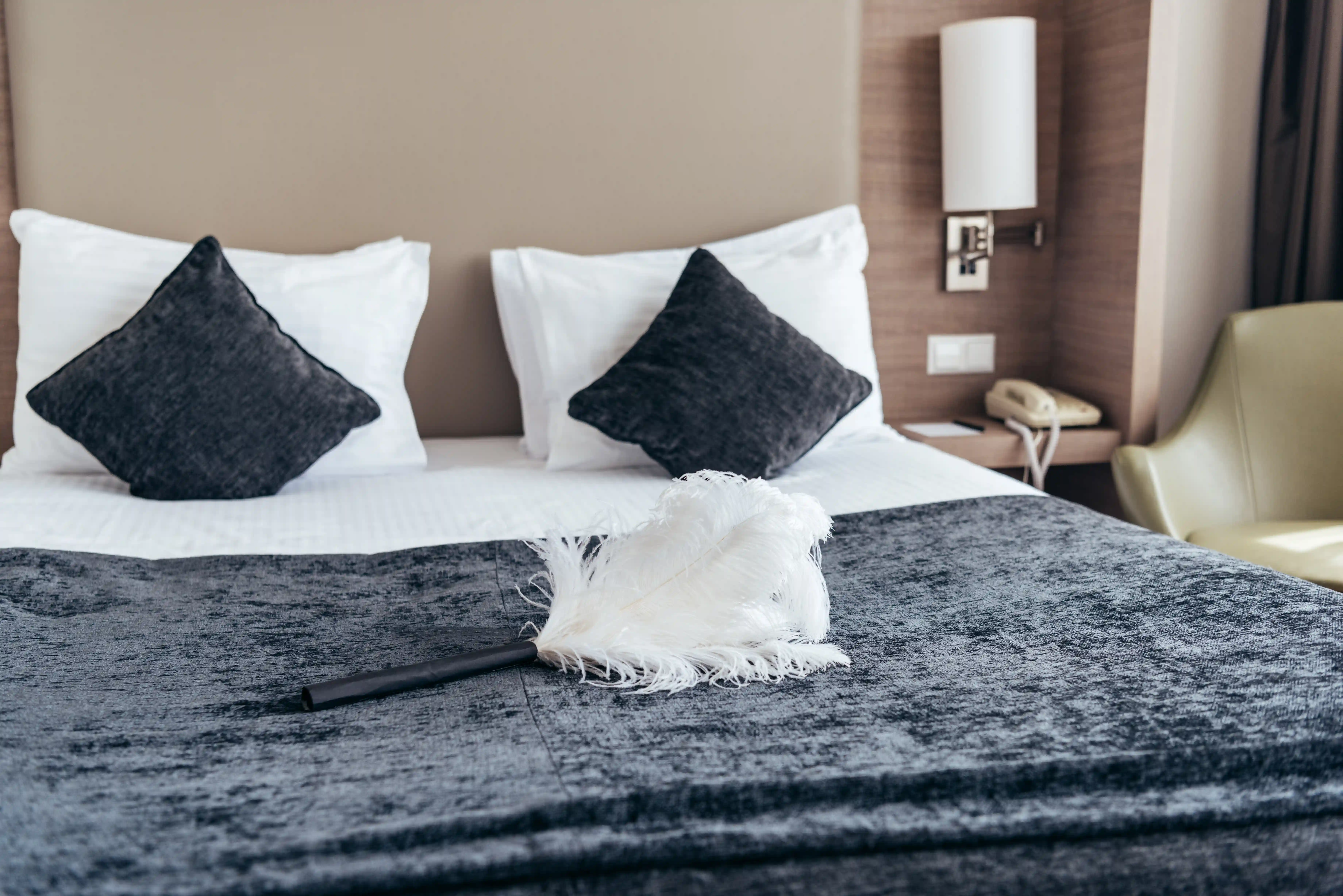
Blanket throws in hotels are more than just decorative accents. These lightweight layers are carefully selected to balance form and function, offering added warmth, texture, and style.
Positioned at the foot of the bed, they serve multiple purposes, enhancing the guest experience while also supporting the hotel’s overall branding and practical needs.
Materials
Hotel blanket throws are typically made from soft, durable materials such as cotton, polyester, microfiber, or acrylic blends. These fabrics are chosen for their ability to retain warmth, resist wrinkling, and hold up well through frequent laundering.
Some upscale hotels may use natural fibers like wool or bamboo blends for a touch of luxury, but most go for machine-washable materials that combine softness and practicality.
Design
The design of a hotel blanket throw is often understated but intentional. Solid colors, muted tones, or subtle patterns are most common, allowing the throw to complement the bedding and overall room decor without clashing.
The texture may be woven, quilted, or knitted, adding a visual and tactile layer that contributes to the bed’s inviting look. A neatly folded throw across the foot of the bed helps convey order, comfort, and attention to detail.
Function
Beyond aesthetics, hotel throws serve a practical role. They offer guests an extra layer of warmth without the need to request more bedding, which is especially helpful in rooms where guests may want to adjust their comfort level. Because they are lighter and smaller than duvets or comforters, throws are also easier to clean and replace between guests.
For housekeeping, throws provide a low-maintenance way to refresh the look of a bed, making the room feel polished and complete.
What Kind of Pillows Do Hotels Use?
Hotel pillows are carefully chosen to meet a wide range of guest preferences while maintaining durability and cleanliness over time. Unlike home pillows, hotel pillows need to offer consistent comfort, support various sleep positions, and withstand frequent washing, all while contributing to the overall luxury feel of the bed.
Types and Pillow Fillings
Hotels typically offer a mix of pillow types to cater to different sleep styles. Common fillings include down, down-alternative, memory foam, and polyester fiberfill.
Down pillows are soft and plush, perfect for those who prefer a cushioned feel, while down alternative pillows are hypoallergenic and easier to maintain. Some hotels also include memory foam pillows for guests needing more structured neck support. The goal is to provide variety so guests can choose a pillow that suits their comfort.
Firmness Options
To appeal to different sleeping positions and preferences, hotels often supply pillows in varying levels of firmness. Soft pillows are ideal for stomach sleepers, while medium-firm options suit back sleepers. Firm pillows, which offer greater support, are favored by side sleepers.
By including multiple options on the bed or upon request, hotels ensure each guest can find the right fit for a restful night’s sleep.
Pillow Protectors
To preserve hygiene and extend the life of each pillow, hotels use anti-microbial pillows with pillow protectors beneath the pillowcases. These are zippered covers made of breathable, washable materials that protect against allergens, moisture, and stains.
They add a layer of defense without compromising softness, helping maintain a fresh and clean sleep surface for every guest.
Why Hotels Use White Bedding
Walk into almost any hotel room and you’ll notice the same thing: crisp, white bedding. This is a deliberate choice rooted in both practicality and design.
White sheets, duvets, and towels convey cleanliness, create a spa-like atmosphere, and reflect the hotel’s attention to detail. Beyond the aesthetic, white luxury hotel bedding plays a strategic role in hotel operations.
Cleanliness and Freshness
White is associated with cleanliness, and it leaves no room to hide stains, dirt, or wear. This transparency reassures guests that the bedding is freshly laundered and hygienic. From a housekeeping perspective, it also simplifies laundry routines; everything can be washed together with bleach, ensuring consistent sanitation and easier inventory management.
Consistency Across Hotels
White bedding helps create a uniform look across rooms and even different hotel branches. It gives the brand a cohesive, elevated feel and simplifies restocking, as there’s no need to match patterns or colors.
For guests, the consistency offers a sense of reliability and comfort, reinforcing the hotel’s standard of quality no matter the location.
How to Achieve Hotel-Like Bedding at Home
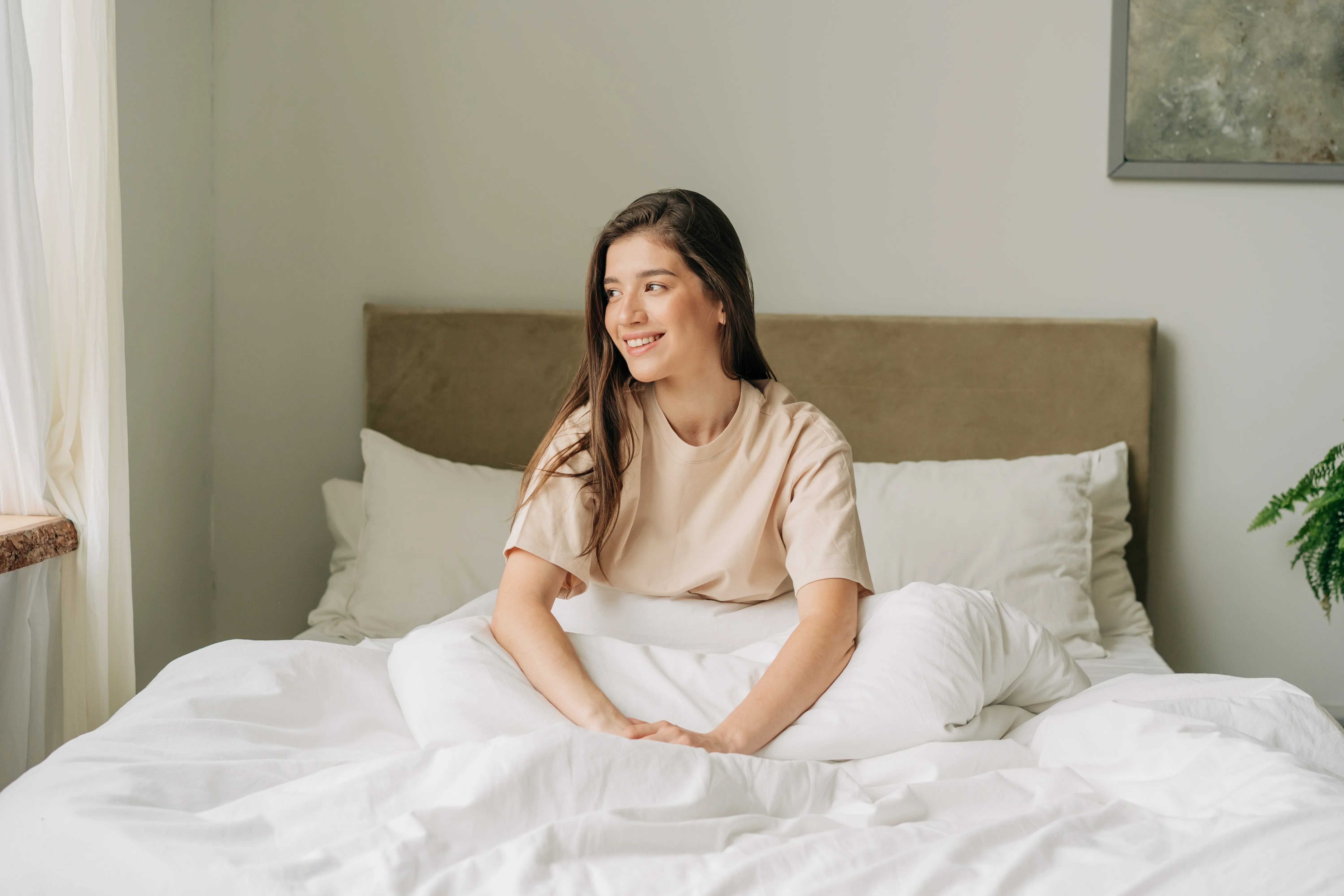
Recreating the cozy, luxurious feeling of hotel bedding at home is easier than you might think. With a few key upgrades and some thoughtful styling, your bed can look and feel just like the ones you find in upscale hotels. The secret lies in the quality of materials, layering techniques, and a commitment to cleanliness and simplicity.
Invest in High-Quality Sheets
Start with soft, breathable sheets made from long-staple cotton like Egyptian or Pima cotton. Look for a percale or sateen weave, depending on whether you prefer crispness or a silky feel.
A quality sheet set not only improves comfort but also enhances the entire look and feel of the bed.
Use a Comforter or Duvet with a Simple Design
Choose a plush comforter or a duvet with a clean, minimal design, ideally in white. Hotels tend to use medium-weight and lightweight inserts that provide warmth without feeling heavy.
If you go for a lightweight duvet, use a washable cover for ease and hygiene. Stick to solid colors or very subtle patterns to keep the look refined and timeless.
Add Luxurious Pillows
Include a mix of soft and firm pillows to mimic the hotel setup, typically two soft and two firm. This layering caters to different sleeping preferences and gives the bed a full, inviting appearance. Choose pillow fillings like down or high-quality down alternatives for a plush, sink-in feel.
Add a Blanket Throw for Style and Warmth
Place a neatly folded blanket throw at the foot of the bed to add an extra layer of warmth and a touch of hotel-style flair. Look for textures that contrast with your main bedding, like a knit or quilted finish, and choose colors that complement your decor while maintaining a calm, cohesive palette.
Use the Triple-Sheeting Technique
For a truly hotel-like experience, layer a flat sheet both underneath and on top of your comforter or duvet insert. This technique keeps the bed hygienic and makes laundry easier. Tuck everything in by using hospital corners to achieve that clean, crisp finish that hotels are known for.
Stick to a Clean, White Color Scheme
White bedding exudes freshness, simplicity, and calm. It also creates a uniform look that's easy to maintain and style. If you want to add a touch of color, do so with small accent pieces like a throw or a decorative pillow, but let white remain the dominant shade.
Keep Your Bedding Fresh
Make your bed every morning and wash your sheets regularly, at least once a week. Rotate pillow inserts and fluff your comforter to keep everything feeling lofty and clean. Attention to cleanliness is what truly elevates a bedroom from ordinary to hotel-grade luxury.
FAQs
What Kind of Bedding Do Most Hotels Use?
Most hotels use high-quality cotton sheets, often with a percale or sateen weave, and a medium-weight duvet or comforter. The bedding is typically white to convey cleanliness and is layered using techniques like triple-sheeting for hygiene and style.
How Often Should I Replace My Hotel-Style Bedding?
For home use, sheets should generally be replaced every 1–2 years, while comforters and duvets can last 3–5 years if properly maintained. Pillows should be replaced every 1–2 years, depending on the fill and wear.
What Thread Count Do Hotels Use for Bed Sheets?
Most hotels go for sheets in the 300–500 thread count range. This offers a perfect balance of softness, breathability, and durability. Rather than chasing high thread counts, hotels prioritize the quality of the cotton and the type of weave, which impacts how the sheets actually feel and perform.
Why Do Hotels Use White Bedding?
Hotels use white bedding to signal cleanliness, simplicity, and freshness. White is easy to bleach and sanitize, and it creates a bright, uniform look that works across various room designs.
How Often is Hotel Bedding Changed?
Hotel bedding is typically changed between every guest stay. In higher-end hotels, sheets and pillowcases may also be refreshed daily during extended stays.
Conclusion
Hotel bedding is known for its comfort, crisp appearance, and luxurious feel, and it's all by design. From high-quality sheets to carefully layered duvets and plush pillows, every detail serves a purpose.
By choosing the right materials, keeping a clean white palette, and using a few simple techniques, you can bring that same hotel-quality sleep experience into your own home.
Dom Abraham
As the lead content writer at Sleepiverse. Dom pours his heart into writing mattress reviews, bedding product reviews, and medically-reviewed health articles. Dom is from Portugal and likes to spend his free time writing on the beach as it gives him a sense of comfort. Aside from writing mattress reviews in front of the soothing beach view, Dom likes to experiment with new amazing food ideas.


